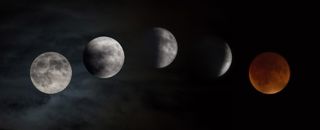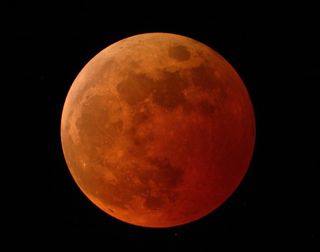
What is a Lunar Eclipse?
- 11th May 2022
- Author: Daniel Milankovic
Origins of the Blood Moon
Although today we simply call this phenomenon a Blood Moon, it wasn’t long ago that lunar eclipses were perceived as bad omens.
Throughout history, lunar eclipses have amazed those who have looked up to the night sky, and with the Moon changing from its usual grey-white tone to a reddish tint, many cultures have often wondered what the meaning of this reddish Moon could foreshadow.
The Incans believed a Blood Moon was because a Jaguar had eaten the Moon (hence its red color), and would throw spears and shout at the Moon in fear that the Jaguar would consume all animals on Earth.
In some Chinese cultures it was perceived that a Blood Moon becoming engulfed in darkness would mean famine or disease would ensue amongst the people. Today, however, we understand that eclipses occur due to the alignment of celestial bodies within our Solar System.
NASA’s Essential Guide to Lunar Eclipses
Credit: NASA Goddard
What Is a Lunar Eclipse?
A lunar eclipse occurs when the Sun, Earth and the Moon are all lined up with each other during the full moon phase of the Moon’s cycle. When this happens, the Moon has a chance to be obscured by the Earth’s shadow, which causes the unique astronomical phenomenon we see as a lunar eclipse.
This doesn’t happen every full moon because the Moon’s orbit is inclined and the orientation of the Moon’s orbit is not fixed in space – it rotates over time (something known as precession). As such, lunar eclipses occur between two and five times a year, but a total lunar eclipse happens about twice every three years.
There are three distinct types of lunar eclipses which can occur dependent on the whereabouts of the Moon during its full moon phase; these are a total lunar eclipse, a partial lunar eclipse and a penumbral lunar eclipse.
-
![Total lunar eclipse.]()
NASA Total lunar eclipse
Also known as a Blood Moon, this eclipse occurs when the Moon passes fully into Earth’s inner shadow (the umbra). This is where the only light to reach the Moon is that which has already been refracted or bent through the Earth’s atmosphere and causes the Moon to glow with a reddish-orange tint.
Due to the Moon having to be completely covered by the Earth’s umbra, total lunar eclipses are quite rare and occur about once every 2.5 years from any given location.
-
![Partial lunar eclipse]()
Peter Thoeny (CC BY-NC-SA 4.0 DEED) Partial lunar eclipse
This type of eclipse occurs when the Moon passes between the inner and outer shadow of Earth, and in this instance the Moon will seem partially tinted a reddish color.
A partial lunar eclipse occurs around three times a year and is the most common type of lunar eclipse, with each partial eclipse appearing slightly different depending on how far across Earth’s inner shadow the Moon is.
-
![Penumbral lunar eclipse.]()
Tomruen (CC BY-SA 4.0 DEED) Penumbral lunar eclipse
This lunar eclipse occurs when the Moon only passes through the outer shadow (the penumbra) of the Earth. The effect of this type of eclipse is that the Moon will appear darker or greyer than a typical full moon. Partial penumbral eclipses are quite common; however, a total penumbral eclipse is actually the rarest type of lunar eclipse due to how narrow the Earth’s outer shadow is compared to the Moon’s diameter, with total penumbral lunar eclipses only occurring between 0-9 times per century.
Lunar Eclipse Calendar
Here is a list of the upcoming Lunar Eclipses visible in the UK:
16 May 2022 (Total Lunar Eclipse)
28 October 2023 (Partial Lunar Eclipse)
25 March 2024 (Penumbral Lunar Eclipse)
18 September 2024 (Partial Lunar Eclipse)
14 March 2025 (Partial Lunar Eclipse)
7 September 2025 (Total Lunar Eclipse)
How to See a Lunar Eclipse
Although when it occurs, a person could theoretically view a lunar eclipse from anywhere where it is nighttime, cloud covered skies and cold early mornings might dampen your chances and enthusiasm to see these spectacular events. Luckily enough, you can watch every lunar eclipse from the comfort of your own home by using live streaming websites such as those provided by timeanddate.com.
Full references / credits:
(Banner image) The supermoon lunar eclipse captured as it moved over NASA’s Glenn Research Center on 27 September, 2015. Credit: NASA/Rami Daud
(1) Artist's enhancement of a full lunar eclipsed Moon. Credit: NASA
Video - NASA | Lunar Eclipse Essentials. Credit: NASA Goddard https://www.youtube.com/watch?v=wuhNZejHeBg
(2a) Lunar eclipse sideview. Credit: NASA
(2b) Animation of the Moon's orbit around the Earth. Credit: Phoenix7777 (CC BY-SA 4.0 DEED) https://en.m.wikipedia.org/wiki/File:Animation_of_Moon_orbit_around_Earth_-_Equatorial_view.gif
(3a) Total lunar eclipse. Credit: NASA
(3b) Partial lunar eclipse. Credit: Peter Thoeny (CC BY-NC-SA 4.0 DEED) https://www.flickr.com/photos/peterthoeny/39343076234
(3c) Penumbral lunar eclipse. Credit: Tomruen (CC BY-SA 4.0 DEED) https://en.wikipedia.org/wiki/November_2020_lunar_eclipse#/media/File:Penumbral_lunar_eclipse_nov-11-2020-tlr1.jpg
(4) Lunar eclipse transition. Credit: NASA








